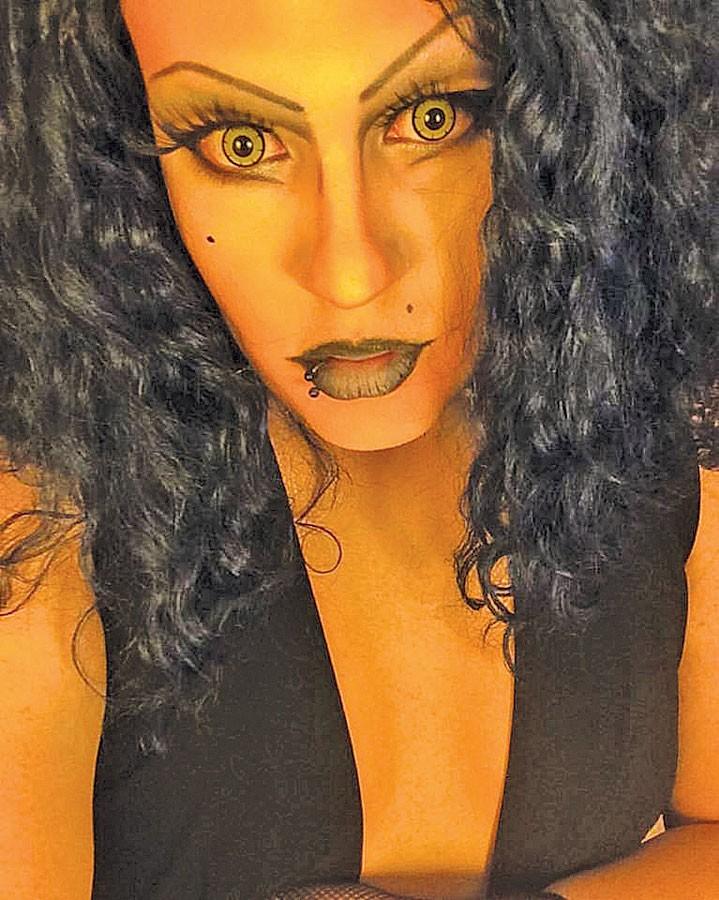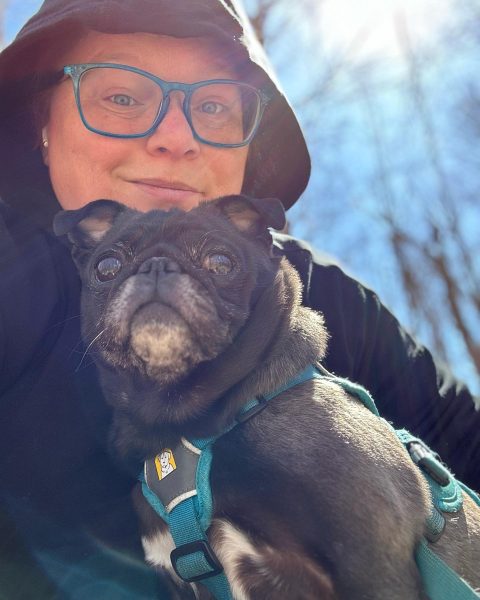Life can be a drag
Aurora Risay
The gentle scent of cucumbers and melons wafts before her face, past the green strands of a wig topped by a red bow, past layers of makeup that smell of cool, dry powders. Her heels are aching from dancing for so long in knee-high platform boots, which are a welcome change from the previous black pumps.
Lights, blinding from overhead, fill her vision. The stage is quiet in the moment before the song starts, punctuated by occasional cheers from random audience members. Gently, the opening notes to Frozen’s “Let it Go” trickle into the silence, and Aurora Risay, the drag queen of Johnson State College, begins to dance.
Chris Austin was first introduced to the world of drag when he was 18; he was shown RuPaul’s Drag Race by his stepmother’s coworker. A seemingly inauspicious event, this would change his life forever. Now, in his senior year at Johnson State College, Austin is a full-on drag queen, the only one on campus.
But what is a drag queen? Or, for that matter, what is a drag race? In this particular context, a drag race is not a contest between high-powered cars, but rather a show by famous drag queen RuPaul.
Like any other culture out there, the culture of drag has a rather large number of facets. For instance, a drag queen is “essentially a male or male-identified person who impersonates a female, or does the feminine makeup,” said Austin. “All that fun stuff.”
Drag queens are just the tip of the iceberg in the world of drag. There are drag kings, which is a “female impersonating a male,” and bio-queens, which are biological females doing the same things as drag queens. But the list doesn’t stop there. It just keeps going with bio-kings, club kids, and even what is called the gender fuck. “[This] is basically, you don’t really know what they’re doing … gender-wise. It’s just some enigma,” said Austin.
“With drag you have a lot of free range, creativity-wise, to do whatever comes to mind,” said Austin. “Generally people are going to appreciate it, or at least someone will appreciate what you do.”
One of the first things people notice about Austin upon meeting him is the lack of eyebrows. Besides giving him a perpetually surprised expression, the lack of eyebrows does actually serve an important function in drag.
“The fun part of having no eyebrows is I get to skip the step of gluing them down, and I can draw them on wherever I want, and however arched I want them,” said Austin. “I have a big forehead, so they could go all the way up if I wanted.”
Eyebrows are just one piece of the puzzle that is Aurora. Each performance could be an entirely new and never-before-seen Aurora, from the top of the hairpiece to the soles of her preferred platform boots.
Another one of the most important pieces of drag is the stage name that the performers go by. The name chosen by Austin holds meaning for a variety of reasons, both personal and otherwise.
“My stage name is Aurora Risay,” said Austin. “I came up with that because for the longest time I’ve been telling people, ‘if I ever have children, my firstborn daughter I wanted to name her Aurora Rose,’ because I love the name Aurora. It’s really pretty and reminds everybody of sleeping beauty. And Rose is my grandmother’s name, on my mom’s side. I tend to go a little to the darker side with my style and everything; some would say it’s a little Goth. So I wanted my name to have a little of that in it, and not be too pretty. I was looking up on the Internet different ways to say a name that meant ‘black rose’ or something. And I actually found ‘Risay,’ which is a Muslim boy’s name for black rose. It had a nice ring to it, so there you go.”
When Austin says that he is the only drag queen on the JSC campus, that isn’t him using hyperbole. While there may be others at JSC who dabble in makeup, or experiment with some of the bolder fashion choices out there, Austin takes it to another level entirely.
“When I or others say that I am the only queen on campus, it pretty much means that no one else on campus does what I do,” said Austin. “No one else on campus has the amount of makeup, wigs, outfits, shoes, tights, and the like that I do — except for maybe a few cosplay folks!”
There is a possibility that JSC will be seeing more queens in the future. “Many students have expressed interest in trying out drag and wanting to learn from me,” said Austin.
“I was intrigued when I saw RuPaul’s Drag Race but I wasn’t sure if it was right for me,” said Austin. “I thought it would be fun to kind of play around in it a bit, and my at-the-time boyfriend was a drag queen. [He] hadn’t really performed or anything; he was a little too young, but was playing around with makeup and showed me the ropes a little bit with that.”
But getting into drag isn’t just a matter of slapping on some makeup, a wig, and an outfit and going out to perform a show. It is an entire lifestyle, which can and does affect almost everything in Austin’s life.
“I would say it mostly influences how I interact with people. Before I started doing drag, I was very much the shy, quiet person that wouldn’t really interact with people all that often,” said Austin. “But as I started getting into drag, people started recognizing me more, and they’ve started talking to me more, which is a lot easier for me when people start talking to me first. People have said I’ve changed since I’ve started doing drag. I went from quiet to kind of sassy.”
As Austin says this, his head bobs in that “oh no you didn’t” motion, complete with the snapping of the fingers in a formation that resembles the letter Z.
“It isn’t really all that difficult juggling Chris and Aurora, especially since I don’t get up into drag too often,” he said. “Most of the time I’m Chris, but I do notice that occasionally little verbal quirks that Aurora has will slip out of my mouth at times, or sometimes I take on a few of her mannerisms without realizing it. I think that just goes to show that the character of Aurora Risay is currently a bit more of an extension of my own personality than a completely separate character [or] being, she is just a more energetic and extroverted version of myself.”
The most enjoyable part of drag for Austin is the transformation, going from one persona to the next, reinventing himself in the process. With just some makeup and a wig, he can go from being Chris Austin, student, to Aurora Risay, the Black Rose.
“It’s really fun to kind of watch yourself change from one person to someone completely different,” said Austin. “And it’s also fun to watch other people do it as well, which is why if I have shows at Higher Ground or some other place, when I do my makeup I’ll be sure to look around the room and watch everybody else. It’s really interesting to see the process.”
However, there is a downside to this drag queen transformation: the shoes. “When you’re standing in heels for about eight hours, it hurts,” said Austin. “You develop things like blood blisters.”
The design of the costume generally depends on the theme of the show. Even within the constraints of that particular theme, there are items of clothing which are preferred.
“I know I like having corsets, that’s something I’ve found,” said Austin. “And I’m definitely a person that really enjoys boots, like platform boots. I can’t do the stiletto heels, I can’t do that. I do not have the balance.”
The theme of the particular show influences everything about the costume. During the Christmas show, performed at Higher Ground in South Burlington, Vermont, “I had that red bathrobe over there, with the green hair and the red bow on it,” said Austin.
Accompanying this outfit was a makeup job that would have made Harvey Dent, Two Face of Batman fame, blush with jealousy. “That was me playing around,” said Austin. “Plus I had to do two outfit changes that night, besides just the red bathrobe. So I just figured, ‘eh, let’s just have fun with the makeup.’”
Throughout all of these shows and performances, Austin pursues a degree in sociology and anthropology, as well as a minor in psychology.
“This works with my drag lifestyle in that you get to people watch, but almost from two different perspectives, both in and out of drag,” said Austin. “Out of drag, people are less apt to come up to me and speak to me, but in drag, people are much more likely to stop me when I’m going somewhere to just talk, ask for a selfie with me, or to compliment my look — outfit, makeup, hair, et cetera.”
The student body, as well as the staff, at JSC does generally appreciate Austin’s drag lifestyle.
“My experience as a drag queen at JSC has been really great,” said Austin. “I actually performed in drag for the first time at the Spring Semester Talent Show back in May of 2013 — I didn’t win, but the reaction from the crowd was amazing! Since then, I have on occasion walked around campus in full drag, just for fun, and the reactions from other students are most of the time supportive. People will often compliment me or just yell supportive remarks at me. I’ve gone to class in drag before as well, and even my professors enjoyed it. I even got two faculty members to agree to be put into drag last year as part of a raffle prize. Margo Warden and Sharon Twigg — I have photo evidence!”
While Austin’s experience at JSC as a drag queen has been fun, every journey must end. Austin graduates at the end of the 2016 spring semester. But while he will be leaving JSC behind, this isn’t the end of drag for him. He will not stop with drag until he can no longer coax a performance from his aged body.
“I think I’ll probably keep doing it until I am physically incapable of doing it anymore,” he said. “Because I think it’s just that much fun, and I actually really enjoy it. I want to keep learning more. I want to learn how to sew, I want to learn how to make outfits and also, this is what so many people get annoyed with newer queens is I actually want to get on that show, RuPaul’s Drag Race, and if were to at least get on, and do well, or the public likes me, I could possibly try to make a career out of it, which would be nice. And plus, if I were to win the show, that’s $100k in the bank, so hey.”






